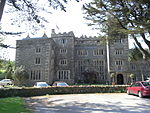Newnham Park

Newnham Park (before circa 1718 Loughtor) is an historic estate in the civil parish of Sparkwell, Devon, UK. It was known as Loughtor until about 1700 when the ancient Strode family, long seated at Newnham, about 1 mile south-east of the manor house of Loughtor, abandoned Newnham and moved their residence to Loughtor (which they had inherited by a marriage in the 16th century) where they built a new mansion house which they renamed "Newnham Park". In 2014 the mansion house with an estate of about 1,550 acres is still owned by a descendant (via various female lines) of the Courtenay and Strode families which held the estate from the 15th century, and which were well established in the county of Devon long before that time. In 2014 part of the estate is operated as a commercial clay-pigeon shooting ground.
Excerpt from the Wikipedia article Newnham Park (License: CC BY-SA 3.0, Authors, Images).Newnham Park
South Hams
Geographical coordinates (GPS) Address Nearby Places Show on map
Geographical coordinates (GPS)
| Latitude | Longitude |
|---|---|
| N 50.4035 ° | E -4.0338 ° |
Address
PL7 5BN South Hams
England, United Kingdom
Open on Google Maps








